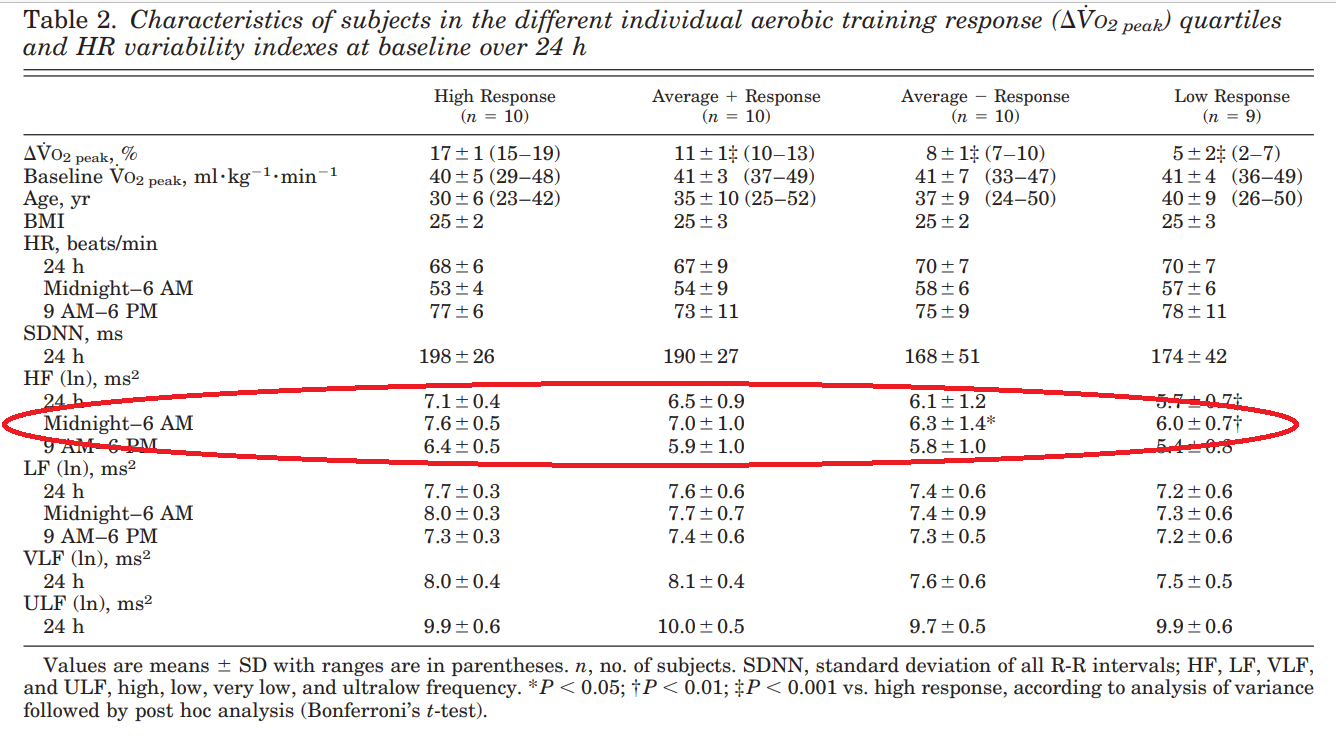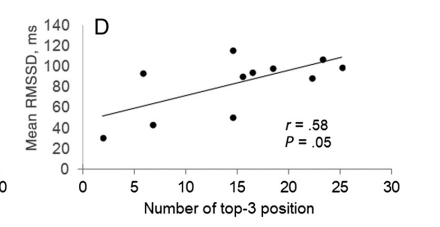Want better fitness bang for your buck? Bump up that HRV!
Alan Couzens, M.Sc. (Sports Science)

In my last post, I outlined (in my mind :-) a bulletproof case for utilizing heart rate variability in your training. Specifically, in that post, I focused on the relationship between heart rate variability and how athletes tolerate the training load, concluding that by implementing regular HRV monitoring, we can better predict how an athlete will tolerate intensive training *before* we push the athlete to do said intensive training. In that post, I also alluded to Heart Rate Variability being a useful metric to predict an athlete's response to intensive training. I want to delve into that relationship a little more in this post.
When talking about "training response", I'm referring to just how much actual fitness improvement an athlete gets for the work they put in. As we all know, every athlete is different & if we give multiple athletes the same training plan, some will get a lot of fitness, most will get some fitness and some may even lose fitness. This typical response curve (from Hautala et al., 2003) is shown below...

In the case of this study, the stimulus was 8 weeks of training for previously untrained individuals. Consisting of 6 x 30 minute sessions @ 70-80% MHR each week for the moderate volume group and 6 x 60 minute sessions @ 70-80% MHR per week for the 'high volume' group. VO2max tests were performed before and after the program. As you can see from the individual response curve, there was a wide range of response to the program, ranging from ~2% improvement to ~20% improvement. Furthermore, there is no clear indication that 'more was better' for the high volume group. While the top 2 improvers did come from the 60min/day group, 6 of the top 10 improvers actually came from the 30min/day group. In fact, 7 of the bottom 10 worst improvers came from the high volume group! In other words, a good number of the participants were doing double the work and achieving half the result. So, if not the volume of training, what was it that separated those who got significantly more fit from those who did not?
Give me an "H". Give me an "R". Give me a "V".... That's right, a large chunk in the difference between the responders & the non responders came down to differences in the athlete's baseline HRV...
Looking at the table below, the big factor that separated the high responders from the low responders was their Midnight - 6 AM High Frequency component of their HRV. The HF component of HRV is a frequency domain feature that represents the strength of the parasympathetic (recovery) systems. You can see from the table that the "High Responders", those with an average improvement in VO2max of 17% had ~27% higher evening HRV numbers than the lowest improving group! (lnHF of 7.6 vs 6.0)

In other words, the big factor that separated how much fitness 'bang' the athletes got for each training 'buck' was their average HRV, with the low HRV group, in some sense, spinning their wheels, doing a lot of training and not getting the fitness improvement that they 'deserved' purely because their HRV was not as high as the high responders.
I found a similar pattern when pulling HRV vs response from my own training group...

Looking at how much the athletes' efficiency factor (power & pace divide by heart rate) improved over the course of a training season, there was a strong relationship between the improvement and the athlete's average morning HRV numbers, with athletes with rMSSD numbers North of 100, consistently showing a fitness improvement of 25% or more over the course of the training year, with those athletes under 50ms rMSSD consistently showing blunted training response, with an improvement of less than 15% over the course of the year.
While my sample is certainly training at a higher level than the Hautala group, it seems that this relationship between HRV and improvement maintains all the way to the very top! A very recent study on the greatest biathlete of modern times, Martin Fourcade showed a similar relationship between HRV and improvements in performance, with the number of top 3 positions each year being strongly related to his HRV...

Interestingly, in the Fourcade study, a drop in HRV in the last year resulted in a noticeable performance drop despite maintaining similar training loads. In 2018, his mean rMSSD was 108ms. In 2019, with a change in training to a more intense approach, his average rMSSD dropped to 94ms. This was associated with a significant drop in performance from 25 top 3 positions in 2018 to only 5 in 2019! I have seen a similar pattern in athletes that I have worked with. As the relationship between life and training changes over time, stress often increases & this increase in stress is shown in HRV. A young athlete with a simple life doing 25 hours a week of aerobic load is in a completely different position to a 35 yo athlete with a job and a family doing the same. Even if the more stressed athlete manages to complete the training, the difference in these 2 scenarios will be shown in how much fitness improvement the athlete gets from the training load. While often dismissed as just the effect of "getting older", I suspect it has far more to do with life getting more "complicated" than many care to admit.
On a strongly related note...
"the lower the stress score, the greater the performance improvement (e.g. a 7.1% performance improvement in the lowest stress score group, and a 1.8% improvement in the highest stress score group)."👏
— Alan Couzens (@Alan_Couzens) November 3, 2020
If you really want to improve, step 1 is designing a simple low stress life! https://t.co/xZkl3M2fVc
So, "I get it", you say, "autonomic stress is bad for performance but life 'is what it is', so what's the solution?"
The solution first and foremost is to recognize that..
"...a training hour is not a training hour any more than an hour of chopping wood is an hour of chopping wood. How much you actually produce depends largely on how sharp your axe is!"
Continuing the metaphor, then, step 1 is to test how sharp your axe is before you get too involved in mindlessly chopping! In other words, monitor your HRV to see if today would be better spend "sharpening the axe" or "chopping". I will say that if you are one of those people with rMSSD values of less than 70-80ms, a lot of your time should be devoted to sharpening your axe rather than chopping.
Abe gets it! Be like Abe!...:-)

So, what are the best ways to sharpen our axe?
* First and foremost, good quality sleep sharpens your axe. Folks who get the recommended 8-10 hours each night have consistently better HRV numbers than those who don't
* Good nutrition & foregoing alcohol sharpens your axe. Sugar & beer blunts it
* Breath focused practices like yoga, tai-chi & meditation sharpen your axe
* Spending time in nature sharpens your axe. Spending all your time indoors blunts it.
* Low intensity training (below VT1) sharpens your axe. Moderate and high intensity training blunts it.
* Finally, living a simple stress-free life, where you learn to say no to stuff that you don't want to do, absolutely sharpens your axe. Taking on too much blunts it to the point that, if you do that too often, you'll be just swinging an axe handle before too long! :-)
The take home point of all this is to hopefully get you to see that the most important metric to be focused on, especially at this time of year, the metric that the improvement of all of the other fancy metrics - VO2max, FTP etc is contingent on, is your Heart Rate Variability. Spend the time to sharpen that axe to a point this year and, when the time comes for chopping, you'll be amazed by just how much improvement you can get for the work you're able to put in.
Train smart
AC
